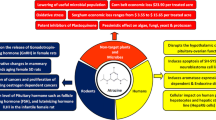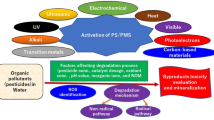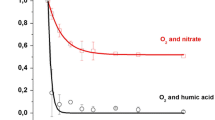Abstract
For 50 years, farmers around the world have relied on the herbicide atrazine—one of the triazine family of herbicides—to fight weeds in corn, grain sorghum, sugar cane, and other crops. Although prohibited in the European Union because of widespread contamination of waterways and drinking water supplies, it is still one of the most widely used herbicides in the world. Atrazine and some of its degradation products are among the most commonly found xenobiotics in groundwater and soils in the world. It is also an endocrine disruptor that causes abnormal reproductive development and immune suppression in wildlife. The purpose of this study was to identify the degradation products of atrazine. Fenton reaction treatment, a hydroxyl radical oxidation process recently developed for the degradation of aqueous pesticide waste, was applied to the degradation of atrazine. Classical and modified Fenton reactions have been used as Advanced Oxidation Process treatment methods. A HPLC method was developed and optimized for the identification of resulting degradation products. In general, very good atrazine degradation efficiencies were achieved by both of the methods used. The degradation products, such as oxalic acid, urea, formic acid, acetic acid, and acetone, were identified by HPLC with a photodiode array detector.
Graphical abstract

Similar content being viewed by others
Explore related subjects
Discover the latest articles, news and stories from top researchers in related subjects.Avoid common mistakes on your manuscript.
Introduction
Nowadays, large amounts of different types of pesticides are used in agriculture. Their environmental impact is not fully known and apparent in some cases. In the agricultural application of pesticides, sorption, bioaccumulation, or their degradation can occur [1]. The impact of pesticides on climate change is also observed [2].
Atrazine is the most used triazine herbicide. It can get into surface and groundwater from soil constituents, where it persists for a longer period because of its slow degradation in water [3]. Atrazine exhibits toxic effects on aquatic organisms. In very small quantities, it can act as an endocrine disruptor of the hormonal system and also as a carcinogen of type C [4]. The most common method of atrazine exposure is the consumption of contaminated water. According to the EC legislation (Council Directive 91/271/EEC of 21 May 1991 concerning urban wastewater treatment as amended, Directive 2000/60/EC of the European Parliament, and of the Council of 23 October 2000 establishing a framework for Community action in the field of water policy as amended) as well as to the relevant Slovak legislation [Parliamentary Act No. 364/2004 Coll. on water as amended, Government Ordinance No. 296/2005 Coll. on surface, waste, and specific moisture (water) as amended] atrazine can be classified as a priority pollutant. In 2002, consumption of atrazine in the Slovak Republic amounted to 84.964 kg per year. Maximum consumption was recorded in the Trnava region (22.489 kg per year) and the minimum in the Zilina region (3.476 kg per year) [5]. Currently, atrazine belongs to the list of dangerous substances relevant to the Slovak Republic, which was developed within the document for reducing water pollution especially by toxic and noxious substances.
Several analytical works have focused on the determination of atrazine in soils, sediments, water, and fruits [6–9]. It was usually analyzed by sensitive analytical methods such as gas or liquid chromatography [8, 10–14]. Electroanalytical methods are known to meet the demand for minimal sample treatment and low consumption of organic solvents [6, 15]. The electrochemistry of atrazine and other triazines has been studied with mercury electrodes, and voltammetric methods have been developed for determination of these compounds [15, 16]. Very few reagents, such as p-aminobenzoic acid, ethyl cyanoacetate, and picric acid, have been reported for the spectrophotometric determination of atrazine [7, 17].
In the field of the treatment of wastewater containing organic compounds, there is a trend to treat water by biological processes. However, there are many pollutants that are toxic or biologically recalcitrant [18, 19]. In this case, it is possible to use Advanced Oxidation Processes (AOPs). Most of the AOPs are based on the generation of hydroxyl radicals, OH, which are able to oxidize almost all organic compounds. The biggest drawback of these procedures is their high costs, except for the Fenton reaction [20, 21]. There are a lot of different AOPs for the degradation of atrazine. Thus, for the TiO2/O3 system, the efficiency reached 98% [22, 23] and for the photo-Fenton reaction 89% [24]. The Fenton reaction has also been used for the degradation of atrazine [21, 25, 26]. Complete mineralization of atrazine was reached by a modified Fenton reaction (Fenton-like reaction, FLR) [27, 28].
The Fenton reaction is based on the reaction of hydrogen peroxide with Fe2+ salts in acidic conditions. Its suitability for water treatment led to a wide range of applications [29, 30]. In wastewater treatment, it is possible to use a Fenton reaction for partial or complete oxidation of biologically recalcitrant and toxic compounds. The efficiency of the Fenton reaction can be increased by using its modification. The new FLR AOP system Fe0/H2O2/H2SO4 utilizes zero-valent iron (Fe0) directly in the Fenton reaction [31]. Generally, the better efficiency of this system is based on the gradual generation of Fe2+ cations from Fe0 during the reaction time (Eq. 1) with a subsequent Fenton reaction (Eq. 2):
It is also important to note that results can be improved by the addition of small portions of hydrogen peroxide during the reaction time [29].
Results and discussion
Regarding the mechanism of the degradation reaction of atrazine by FR/FLR reactions, we can reach conclusions on the basis of HPLC data for the following products and intermediate products. The standard chromatogram of atrazine with a retention time of 12.67 min is demonstrated in Fig. 1. As shown in Fig. 2, after 5 min a wide series of reaction intermediates was observed, such as oxalic acid, formic acid, acetic acid, and acetone (Table 1). The formation of these products are presented in simplified Scheme 1. The transformation pathways depicted in Scheme 1 summarize many primary, secondary, and tertiary intermediates [32, 33]. All of them can be sorted into two groups of intermediates. The first group presents very reactive and unstable radical intermediates that can react by decomposition reactions. The second group contains less reactive and thus relatively stable intermediates that can be further degraded by radical intermediates (including hydroxyl radicals formed during Fenton reaction) or can be hydrolyzed to the more stable intermediates or final products such as acetone, acetic acid, oxalic acid, or formic acid. Scheme 1 shows that the total mineralization to CO2 and H2O is also proposed.
Because of the great stability of the s-triazine moiety of atrazine, on the other hand, many different dealkylated, dechlorinated, and hydroxylated new triazine intermediates should be formed [21], but our attention was focused on the small fragments of the degradation process that were identified by HPLC. It has been suggested that 2-hydroxy-4,6-diamino-s-triazine is the most stable final triazine product [21].
In Figs. 3 and 4, we observed different degradation products of atrazine by FR and FLR. This difference is caused by varied oxidation powers of emerging products. Degradation of atrazine by the modified system Fe0/H2O2/H2SO4 is somewhat different from a typical FR; the reaction intermediates are oxalic acid, urea, formic acid, acetic acid, and acetone (Table 1). An increase of acetone concentration depends on the atrazine concentration in the system (Figs. 2, 3).
In the next step, we were concerned with the degradation of the reaction intermediates of atrazine. After complete degradation of atrazine, we observed a decrease of the acetone concentration, which was degraded to formic acid with a retention time of 2.04 min (Fig. 5). Subsequently, we focused on studying the influence of the hydrolysis of generated products after the Fenton reaction (Fig. 6). When we compared degradation products in the chromatograms in Figs. 5 and 6, a small concentration increase of some products was observed (urea, formic acid, and acetic acid).
Radical processes of both Fenton and Fenton-like reactions are major degradation pathways in the first short-time part of the reaction followed by the hydrolytic reactions to form small organic molecules such as formic and acetic acids in the second long-time part of the reaction. These facts are of great importance for real polluted environmental systems. It seems that both acetamide and formamide were also formed in the second long-time reaction part from appropriate acids and ammonia. Very similar UV spectra of both of these compounds make their correct identification difficult. The small shifts of retention times of the studied degradation products might have been caused by an insufficient time for the post-analysis washing of the stationary phase by the mobile phase with initial composition or by column aging.
In this article, besides the classic Fenton reaction the new modified Fenton AOP system Fe0/H2O2/H2SO4 was firstly used for the degradation of atrazine.
Conclusions
In our study, degradation products of atrazine were identified by HPLC after application of the Fenton reaction and modified Fenton reaction. Atrazine was gradually dissolved, and two different degradation pathways were suggested. The new modified Fenton AOP system Fe0/H2O2/H2SO4 was firstly used for the degradation of atrazine.
Our results show that both Fenton and Fenton-like reactions are able to degrade atrazine to toxicologically inactive small organic molecules such as oxalic acid, urea, formic acid, acetic acid, and acetone, or are able to mineralize atrazine to form CO2 and H2O.
Experimental
Chemicals and reagents
Ferrous sulfate heptahydrate (FeSO4.7H2O, purity 98%), hydrogen peroxide (H2O2) 30% solution, sulfuric acid (H2SO4) 5% and 20% solution, sodium hydroxide (NaOH) 20% solution. All used chemicals were purchased from Lachema (Brno, Czech Republic) except for the atrazine standard (Agrovita, Ivanka pri Dunaji, Slovak Republic) with a purity of 98%.
Instrumentation
Each experiment was carried out in a 500 cm3 Erlenmeyer flask. All solutions were prepared in deionized water. Stirring of the reaction mixture was performed using a Teflon-coated bar at approximately 300 rpm with a magnetic stirrer (MMA, Germany). The reaction temperature was 25 °C. All pH measurements were carried out by a digital ion pH meter (Ion Activity Meter MS-20). The degradation products of atrazine were identified by HPLC (Young Lin Instruments, YL9100 HPLC system, South Korea) with a photodiode array detector (PDA, Young Lin Instruments, YL9160, South Korea).
Sample preparation: degradation of atrazine by Fenton reaction (FeSO4·7H2O and H2O2)
The following procedure was used for the degradation of atrazine: 10 mg of atrazine was added to an Erlenmeyer flask (500 cm3) containing 300 cm3 of deionized water. To this solution with intensive stirring the necessary amount of FeSO4·7H2O and H2O2 in the primary ratio (H2O2: FeSO4 = 875:500 mg dm−3) were added. The reaction times for these experiments were 5 min, 24, and 72 h. After 72 h, the reaction mixture was left standing for 72 h and neutralized by 20% NaOH. After filtering off the resulting precipitate, degradation products of atrazine in the filtrate were determined by HPLC. For all different reaction times used, all samples for HPLC analysis were prepared by the neutralization and filtration of the given reaction mixture. All reactions were carried out under daylight.
Sample preparation: degradation of atrazine by modified Fenton reaction (Fe0/H2O2/H2SO4)
To compare the efficiency of the degradation of atrazine, the modified Fenton reaction procedure was also used: 10 mg of atrazine was added to an Erlenmeyer flask (500 cm3) containing 300 cm3 deionized water. To this solution with intensive stirring 0.05 cm3 concentrated H2SO4 was added, and then approximately 3 g of activated Fe shavings (technical shavings were cleared by soap, washed by distilled water, activated by 20% H2SO4, rewashed by deionized water, and immediately used in the reaction). After the induction time (10 min), the necessary amount of H2O2 (0.8 cm3 30% H2O2) was added. The reaction time for the experiment was 24 h. Then the reaction mixture was neutralized by 20% NaOH. After filtering off the resulting precipitate, degradation products of atrazine in the filtrate were determined by HPLC. All reactions were carried out under daylight.
HPLC analysis
The degradation products of atrazine were analyzed by HPLC with a PDA detector, using a reversed phase column (GraceSmart, RP-18, length 150 mm, ID 4.6 mm). The spectra were recorded from 190 to 900 nm, and chromatograms were monitored at 200, 210, 222, and 235 nm. The temperature of the column oven was set to 25 °C. The sample was dissolved in water and injected into the HPLC column. Methanol:water was used as the mobile phase for analysis, while the ratio of these two phases was gradually changed during the analysis from 10:90 to 90:10. The flow rate was 1 cm3 min−1. The injection volume was held constant at 10 mm3. The multi-wavelength detector can monitor the degradation products of atrazine continuously between 190 and 900 nm, which enables the UV and visible regions to be monitored simultaneously. The spectra were recorded and stored in the HPLC spectrum library. The criteria for the identification of degradation products of atrazine were established by comparison of the retention time and spectrum of an unknown compound with standards.
References
Hesketh N, Jones NM, Tipping E (1996) Anal Chim Acta 327:191
Claver A, Ormad P, Rodriguez L, Ovelleiro JL (2006) Chemosphere 64:1437
Singh N, Megharaj M, Kookana SR, Naidu R (2004) Chemosphere 56:257
Abarikwu OS, Adesiyan AC, Oyejola OT, Oyeyemi OM, Farombi OE (2009) Fertil Steril 91:S8
Hiller E, Krascsenits Z, Kútnik P, Bartaľ M (2004) Geochémia. Dionyz Stur, Bratislava
Maleki N, Absalan G, Safavi A, Farjami E (2007) Anal Chim Acta 581:37
Kesari R, Gupta VK (1998) Talanta 47:1085
Wulfeck-Kleier KA, Ybarra MD, Speth TF, Magnuson ML (2010) J Chromatogr A 1217:676
Min G, Wang S, Zhu H, Fang G, Zhang Y (2008) Sci Total Environ 396:79
Ahel M, Evans KM, Fileman TW, Mantoura RFC (1992) Anal Chim Acta 268:195
Zhoua Q, Xiao J, Wang W, Liu G, Shi Q, Wang J (2006) Talanta 68:1309
Katsumata H, Kaneco S, Suzuki T, Ohta K (2006) Anal Chim Acta 577:214
Bohuss I, Bozóki J, Barkács K, Záray G (2003) Microchem J 74:165
Tomkins BA, Ilgner RH (2002) J Chromatogr A 972:183
Luciana dos Santos BO, Abate G, Masini JC (2004) Talanta 62:667
Luciana dos Santos BO, Silva MSP, Masini JC (2005) Anal Chim Acta 528:21
Tamrakar U, Mathew SB, Gupta VK, Pillai AK (2009) J Anal Chem 64:386
Wang XJ, Song Y, Mai JS (2008) J Hazard Mater 160:344
Veiseh O, Kievit MF, Gunn WJ, Ratner DB, Zhang M (2009) Biomaterials 30:649
Kassinos D, Varnava N, Michael C, Piera P (2009) Chemosphere 74:866
Chan HK, Chu W (2005) J Hazard Mater 115:227
Zhanqi G, Shaogui Y, Na T, Cheng S (2007) J Hazard Mater 145:424
Farré MJ, Franch MI, Malato S, Ayllón JA, Peral J, Doménech X (2005) Chemosphere 58:1127
Badawy MI, Ghaly MY, Gad-Alleh TA (2006) Desalination 194:166
Chu W, Chan HK, Kwan YC, Choi YK (2007) Chemosphere 67:755
Balci B, Oturan N, Cherrier R, Oturan AM (2009) Water Res 43:1924
Kim G, Jeong W, Choe S (2008) J Hazard Mater 155:502
Bandala E, Domínguez Z, Rivas F, Gelover S (2007) J Environ Sci Health B 42:21
Prousek J, Palacková E, Priesolová S, Marková L, Alevová A (2007) Sep Sci Technol 42:1505
Devi GL, Kumar GS, Reddy MK, Munikrishnappa C (2009) J Hazard Mater 164:459
Prousek J, Priesolová S (2002) Chem Listy 96:893
Russell GA (1957) J Am Chem Soc 79:3871
Rebelo SLH, Pereira MM, Monsanto PV, Burrows HD (2009) J Mol Catal A: Chem 297:35
Acknowledgments
The authors thank the Grant Agency of the Slovak Republic (VEGA grants no. 1/0390/09, 1/0866/08, and 1/0182/11) for financial support.
Author information
Authors and Affiliations
Corresponding author
Rights and permissions
About this article
Cite this article
Mackul’ak, T., Prousek, J. & Švorc, L. Degradation of atrazine by Fenton and modified Fenton reactions. Monatsh Chem 142, 561–567 (2011). https://doi.org/10.1007/s00706-011-0504-8
Received:
Accepted:
Published:
Issue Date:
DOI: https://doi.org/10.1007/s00706-011-0504-8











